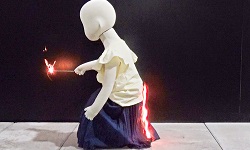Protect children from firework-related burns! Children aged three or younger are most injured. In some cases, clothing catches fire
Fireworks are a feature of summer in Japan. When children play with them, however, sometimes they get burned. Fireworks used by consumers in housing areas, etc. are called toy fireworks (hereafter called "fireworks").
The Medical Facilities Network1 received 60 cases of firework-related burns in five years from fiscal 2018 through fiscal 2022. More than half of the injured were children aged between one and three. There are age-specific trends. In some cases, the victims' clothing caught fire.
Therefore, NCAC has conducted product tests to examine risks of firework-related burns and clothing ignition based on the cases reported to the Medical Facilities Network in order to share child safety precautions and issue a consumer alert.
- 1 The Medical Facilities Network is a joint project by the Consumer Affairs Agency and NCAC which started operating from December 2010. The network collects accident reports on people receiving treatment at medical facilities after suffering life-threatening or bodily injuries in their daily lives.
Cases reported to the Medical Facilities Network
Burns from sparks
- When a child ignited a firework in a park, the child was surprised by sparks and swung the firework. Then, the firework was attached to the left arm.
- When playing with fireworks, a child tried to grab sparks and got burned.
Burns from clothing ignition
- When a carer looked away for a second, sparks fell on a child's left shoe and burned.
- Soon after a child waved a firework in the air, sparks were blown by the wind and fell on the child's skirt. The skirt was ignited by the sparks.
Burns from cinders
- A child touched cinders from a sparkler with the right-hand fingers and got burned.
- When a sparkler burned out, a child touched a residue on the ground with the right hand and got burned.
Video
- * Please note that the video includes a big sound.

Video: Protect children from firework-related burns! (Japanese version)
Test Results
Simulation of dangerous situations
- When holding a firework against the wind, it appears that a person with skimpy clothes and shoes are prone to burns from sparks, etc.
- When sparks fall onto the wet ground, the sparks can burst and spread.
- When cinders fall on the hem of a skirt, the cinders can ignite.
Temperature of cinders
- While you may think that cinders are not so hot, actually they maintain a high heat for a while after falling onto the ground or being extinguished, which can cause burns if you touch them. Care is required when handling cinders and embers.
Labeling
All the tested products are provided with precautionary information on its package (e.g. "Do not allow children aged three or younger to hold the product," "Do not use the product on a windy day.")
Advice for consumers
- There have been numerous firework-related burns mainly among children aged three or younger. Follow the instruction manual and do not allow children aged three or younger to hold a firework. Keep a distance when showing fireworks.
- Take extra care when children wear skimpy clothes, clothes with wide hems or sandals. Do not let children stand on the leeward side of fireworks. Do not allow children to play with fireworks if it's windy.
- Prepare a bucket of water in advance to prevent any accidents. Remember to stop, drop and roll when clothing catches fire.
- As soon as a firework burns out, put it in the water. Even if the temperature of cinders looks low, they may maintain a high heat.
Request to businesses
- Continue to provide safety precautions and to raise consumer awareness in order to prevent burns from fireworks.
Request to the government
- Continue to provide safety precautions and to raise consumer awareness in order to prevent burns from fireworks.
